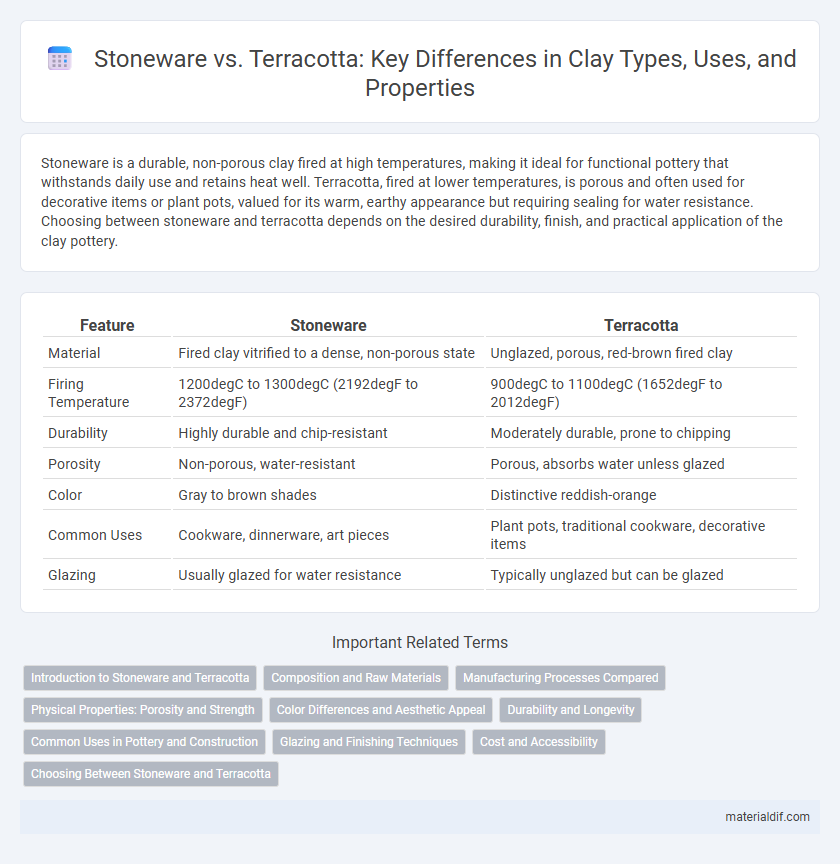Stoneware is a durable, non-porous clay fired at high temperatures, making it ideal for functional pottery that withstands daily use and retains heat well. Terracotta, fired at lower temperatures, is porous and often used for decorative items or plant pots, valued for its warm, earthy appearance but requiring sealing for water resistance. Choosing between stoneware and terracotta depends on the desired durability, finish, and practical application of the clay pottery.
Table of Comparison
| Feature | Stoneware | Terracotta |
|---|---|---|
| Material | Fired clay vitrified to a dense, non-porous state | Unglazed, porous, red-brown fired clay |
| Firing Temperature | 1200degC to 1300degC (2192degF to 2372degF) | 900degC to 1100degC (1652degF to 2012degF) |
| Durability | Highly durable and chip-resistant | Moderately durable, prone to chipping |
| Porosity | Non-porous, water-resistant | Porous, absorbs water unless glazed |
| Color | Gray to brown shades | Distinctive reddish-orange |
| Common Uses | Cookware, dinnerware, art pieces | Plant pots, traditional cookware, decorative items |
| Glazing | Usually glazed for water resistance | Typically unglazed but can be glazed |
Introduction to Stoneware and Terracotta
Stoneware is a dense, non-porous ceramic fired at high temperatures, typically between 1,200degC and 1,300degC, making it durable and ideal for functional pottery and cookware. Terracotta, characterized by its porous, reddish-brown clay body, is fired at lower temperatures around 1,000degC and is commonly used for decorative objects and garden pots. The distinct firing process and composition of stoneware and terracotta influence their strength, porosity, and typical applications in ceramics.
Composition and Raw Materials
Stoneware consists primarily of kaolin, ball clay, feldspar, and quartz, providing a dense and vitrified structure after firing at high temperatures between 1200degC and 1300degC. Terracotta is made from iron-rich clays with a high level of impurities and organic materials, resulting in a porous, reddish material fired at lower temperatures around 900degC to 1100degC. The mineral composition and firing temperature differences significantly impact the durability, water absorption, and color characteristics of stoneware and terracotta ceramics.
Manufacturing Processes Compared
Stoneware is fired at a higher temperature, typically between 1,200degC and 1,300degC, which vitrifies the clay and makes it non-porous and durable. Terracotta undergoes firing at lower temperatures, around 1,000degC, resulting in a porous and softer material that retains its natural reddish color. The manufacturing process of stoneware involves more controlled kiln atmospheres to achieve vitrification, whereas terracotta production is often simpler, focusing on rustic and breathable qualities.
Physical Properties: Porosity and Strength
Stoneware exhibits low porosity and high strength due to its dense, vitrified structure, making it highly durable and water-resistant. Terracotta, characterized by higher porosity and a more porous matrix, offers lower strength and greater water absorption, limiting its use in wet environments. The physical properties directly affect their functionality, with stoneware ideal for robust, moisture-prone applications while terracotta suits decorative and breathable purposes.
Color Differences and Aesthetic Appeal
Stoneware typically exhibits a range of neutral tones such as gray, brown, and beige, offering a sleek and contemporary aesthetic ideal for modern decor. Terracotta features rich, warm hues of reddish-orange and earthy browns, delivering a rustic and traditional appearance that enhances natural and artisanal settings. The color differences between stoneware and terracotta significantly influence their aesthetic appeal, with stoneware favoring subtle sophistication and terracotta emphasizing warmth and organic charm.
Durability and Longevity
Stoneware exhibits superior durability and longevity compared to terracotta due to its high firing temperature of approximately 1200-1300degC, resulting in a dense, vitrified, and non-porous structure that resists chipping and cracking. Terracotta, fired at lower temperatures around 1000degC, remains porous and more susceptible to weathering, moisture absorption, and structural degradation over time. These inherent material properties make stoneware ideal for functional pottery and outdoor use, while terracotta suits decorative applications requiring less durability.
Common Uses in Pottery and Construction
Stoneware's durability and strength make it ideal for functional pottery like dinnerware, cookware, and storage jars, as well as construction materials such as tiles and bricks. Terracotta, known for its porous nature and rustic appearance, is commonly used in decorative pottery, garden pots, and architectural elements like roof tiles and ornamental facades. Both materials serve distinct roles in pottery and construction, with stoneware favored for practical applications and terracotta prized for aesthetic and traditional uses.
Glazing and Finishing Techniques
Stoneware features a dense, non-porous body that readily accepts a variety of glazes, resulting in a durable, vitrified finish ideal for functional ware. Terracotta, with its porous, reddish clay body, often remains unglazed or is treated with slips and matte finishes to preserve its rustic, earthy aesthetic. Glazing techniques on stoneware typically involve high-temperature firings to achieve glossy, glass-like surfaces, whereas terracotta favors low-temperature finishes that highlight its natural texture and warm tones.
Cost and Accessibility
Stoneware clay typically incurs higher costs due to its durability and firing temperature requirements, making it less accessible to beginners and hobbyists. Terracotta clay, being more affordable and widely available, is favored for its ease of use and lower firing temperatures. For budget-conscious artists or educational settings, terracotta offers a cost-effective and accessible choice compared to the premium pricing of stoneware.
Choosing Between Stoneware and Terracotta
Stoneware offers high durability and resistance to chipping with its dense, vitrified composition, making it ideal for heavy-use kitchenware and outdoor pottery. Terracotta, characterized by its porous, reddish-brown clay, provides a rustic aesthetic and excellent breathability, which benefits plant pots and traditional cookware requiring moisture regulation. Choosing between stoneware and terracotta depends on the desired balance between strength, porosity, and visual appeal for specific ceramic projects.
Stoneware vs Terracotta Infographic

 materialdif.com
materialdif.com